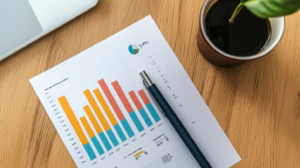
Present Simple Tense 1
English Blogs “Let’s Learn, Explore, and Connect to the World” Present Simple Tense 1 I. Introduction to the Present Simple Tense in English Mastering the




In the competitive realm of digital marketing, tracking and measuring campaign performance is crucial for marketers to understand the impact of their strategies. With Facebook’s massive user base and sophisticated advertising tools, it’s one of the most valuable platforms available today. However, the true power lies in leveraging Facebook Analytics and conversion tracking to directly attribute sales and leads to your marketing efforts.
Facebook Analytics offers an array of insights into customer behavior, engagement, and interactions. By understanding the journey your customers take across different devices and channels, you can tailor your strategies to meet their specific needs and improve conversion rates. Conversion tracking further refines this process by allowing marketers to measure key actions, such as purchases or form submissions, tied to specific ads.
Facebook’s advanced attribution models and tracking features empower marketers to dig deeper into campaign performance. For instance, you can determine whether a campaign effectively targets the right audience or whether a particular creative resonates more with users. Additionally, understanding the attribution models used helps ensure an accurate representation of your ROI.
This comprehensive guide will explore the tools, strategies, and best practices required to accurately measure the ROI of your Facebook campaigns. From understanding the nuances of attribution models to setting up conversion tracking and analyzing campaign data, this guide will provide you with the knowledge to attribute success directly to your Facebook efforts. By gaining mastery over these tools, you’ll be equipped to optimize campaigns, refine your marketing strategy, and drive meaningful business results.

Facebook Analytics provides an in-depth examination of user behavior across multiple devices and channels, offering marketers a wealth of insights to fuel their strategy. By understanding how users interact with your business’s digital properties, you can identify patterns, optimize funnels, and improve overall marketing performance. Let’s break down some key features that make Facebook Analytics a valuable tool for marketers:
This feature helps you visualize the customer journey from initial awareness to conversion. By identifying stages where users drop off, you can detect bottlenecks and opportunities for improvement; this will help you improve your approach and get more people to take the desired action.
Analyze data by dividing it into specific segments based on behavior, demographics, or interests. This segmentation enables more granular analysis, helping tailor marketing strategies to different groups and improving engagement.
Gauging the long-term value of your customers helps you allocate resources more effectively. With CLV insights, you can identify high-value segments and develop targeted campaigns to maximize lifetime revenue.
Apart from Facebook Analytics, Facebook also offers an Insights platform that breaks down performance metrics in an accessible way:
These insights provide a comprehensive view of organic and paid performance, helping marketers refine content strategy and optimize ad spend.
To make the most of these tools, it’s crucial to set up Facebook Analytics correctly:
By understanding Facebook Analytics and Insights, marketers can identify what drives their audience to take desired actions. By using data to guide your marketing, you can develop campaigns that reach exactly the right people, better ad spend optimization, and ultimately helps attribute sales and leads directly to your Facebook marketing efforts.

Conversion tracking is a method that allows marketers to keep track and analyze the actions users take after engaging with your Facebook ads. Whether it’s completing a purchase, subscribing to a newsletter, or responding to a contact form, tracking these actions provides a deeper understanding of your ads’ effectiveness in achieving your business goals.

By identifying which ads drive conversions most effectively, marketers can refine targeting parameters, adjust ad messaging, and experiment with different placements to improve campaign performance.
With clear conversion data, marketers can prepare more of their advertising budget to the ads that deliver the highest return on investment (ROI). This approach ensures that marketing spend focuses on strategies that generate meaningful business results.
Facebook conversion tracking complements other marketing methods, providing a holistic view of your customer’s journey. This enables marketers to understand how Facebook ads interact with email campaigns, SEO, and other efforts, leading to better multi-channel optimization.
When we say Facebook pixel, it is a small piece of code placed on your website that tracks user activity. It monitors actions like page views, purchases, and form submissions, linking them back to your Facebook ads. This data provides valuable insights into how users move through your website after engaging with your campaigns.
To gain more specific insights, you can define unique conversion events that align with your business goals. Whether it’s signing up for a webinar or downloading a whitepaper, custom conversions allow you to measure the specific actions that matter most.
Aggregated Event Measurement helps marketers track user actions across different devices while respecting user privacy. This feature supports businesses in measuring critical conversion events, even under new data privacy restrictions.
 In summary, conversion tracking is essential for understanding the impact of your Facebook advertising efforts. By properly configuring the Facebook pixel, defining custom conversions, and leveraging Aggregated Event Measurement, marketers can gain a clearer view of user actions and align their strategies to maximize campaign performance and business impact.
In summary, conversion tracking is essential for understanding the impact of your Facebook advertising efforts. By properly configuring the Facebook pixel, defining custom conversions, and leveraging Aggregated Event Measurement, marketers can gain a clearer view of user actions and align their strategies to maximize campaign performance and business impact.

Attribution tracks how various interactions influence customers and ultimately lead them to convert. It answers critical questions about which channels and interactions influence a customer’s decision to convert, helping marketers better understand how each engagement with their brand contributes to the final conversion. By leveraging the right attribution model, you can uncover insights that help you allocate your advertising budget more effectively and refine your overall marketing strategy.
This model attributes all credit to the final touchpoint that directly precedes the conversion event. It’s ideal for tracking immediate actions but doesn’t capture the broader influence of previous interactions.
In contrast, the First Click model assigns credit to the initial touchpoint that introduced the user to your brand. It’s useful for understanding which channels are effective in generating initial interest.
The Linear model evenly distributes credit across all touchpoints leading up to the conversion. It recognizes the cumulative impact of multiple engagements on conversion behavior.
Time Decay models prioritize touchpoints that are closer to the conversion event, providing them with higher weight while giving less credit to earlier interactions. This model is suitable for campaigns with long consideration periods.
Position-based models assign most credit to the first and last touchpoints, while the remaining interactions receive a smaller, evenly distributed share of credit. This approach recognizes the importance of both the initial introduction and the final push towards conversion.
By understanding attribution models and selecting the one that aligns best with your customer journey, you’ll gain a clearer view of which Facebook campaigns are driving in conversions and how each touchpoint contributes to your marketing goals. By understanding how customers interact with your brand, you can make smarter choices about where to spend your money, refine your messaging, and develop a winning marketing strategy.
The Facebook Attribution tool is a powerful resource that allows marketers to compare various attribution models and understand how each one impacts campaign performance. By doing so, it offers deeper insights into how users respond to your ads in multiple channels and devices, enabling you to make data-driven decisions on budget allocation and campaign optimization.
 Facebook’s Attribution tool lets you see the big picture of how various marketing efforts on different platforms contribute to sales or other desired actions. Whether it’s paid advertising, organic social media, email marketing, or direct website traffic, these multi-channel insights enable you to see the combined impact of your marketing efforts.
Facebook’s Attribution tool lets you see the big picture of how various marketing efforts on different platforms contribute to sales or other desired actions. Whether it’s paid advertising, organic social media, email marketing, or direct website traffic, these multi-channel insights enable you to see the combined impact of your marketing efforts.
 In today’s multi-device world, users often interact with your brand on desktops, smartphones, and tablets before making a purchase. Facebook Attribution’s cross-device reporting helps you trace the customer journey across all devices, providing a more comprehensive view of user behavior and uncovering conversion opportunities.
In today’s multi-device world, users often interact with your brand on desktops, smartphones, and tablets before making a purchase. Facebook Attribution’s cross-device reporting helps you trace the customer journey across all devices, providing a more comprehensive view of user behavior and uncovering conversion opportunities.
Link all relevant Facebook ad accounts and business data, such as your CRM system, to provide the tool with a full dataset.
Choose an attribution window that matches your business cycle. Common options include 1, 7, and 28 days.
Use different attribution models to analyze campaign performance from multiple perspectives. Compare results to see which models provide the most accurate view of your customer journey.
 By effectively utilizing the Facebook Attribution tool, you can have a grasp of a comprehensive understanding of your campaigns’ performance, refine your marketing strategy, and attribute conversions more accurately across channels and devices.
By effectively utilizing the Facebook Attribution tool, you can have a grasp of a comprehensive understanding of your campaigns’ performance, refine your marketing strategy, and attribute conversions more accurately across channels and devices.

Start by clearly outlining the goals you want to measure and ensure they align with your business objectives. Whether it’s driving sales, generating leads, or building brand awareness, having precise KPIs helps tailor your analytics and conversion tracking approach. This clarity enables focused campaign optimization and a better understanding of which metrics matter most.
Make a habit of reviewing your analytics dashboard and conversion metrics weekly or bi-weekly. Regular analysis ensures that you catch any performance issues early and adapt to emerging trends quickly. By staying updated, you can keep your campaigns aligned with your goals and adjust strategies as needed.
Most Facebook users access the platform primarily through mobile devices, so it’s crucial to optimize your website and ads accordingly. Ensure that mobile users have a smooth experience by creating responsive landing pages and mobile-optimized ad creatives. This guarantees maximum engagement and conversion rates from mobile traffic.
Segmenting your audience allows for more accurate analysis and targeted campaigns. With Facebook’s Custom Audiences feature, you can target groups based on behavior, demographics, and past interactions. Use this data to retarget users who have shown interest and improve your conversion rates.
Test different creatives, messaging, and placements to discover what resonates best with your audience. A/B testing helps identify the most effective combinations that drive higher click-through rates, engagement, and conversions, enabling more refined campaign strategies.
Sync your Facebook Analytics with Google Analytics and other tools to get a comprehensive view of customer behavior across different platforms. By taking this data-driven approach, marketers gain a complete picture of how customers interact with their brand across various channels. This allows them to create a seamless and effective multi-channel marketing strategy.
Regularly audit your pixel tags to ensure the data captured is accurate and complete. Check for redundant or erroneous tags that could skew your insights, ensuring that decisions are based on clean data.
By adhering to these best practices, you’ll maximize the value of Facebook Analytics and conversion tracking, leading to improved campaign performance and a stronger marketing strategy.

Creating custom dashboards is essential for efficiently visualizing data relevant to your Facebook campaigns. By building dashboards tailored to your goals, you can easily monitor campaign performance at a glance. Include key metrics like conversions, click-through rates, and return on ad spend (ROAS). By creating custom dashboards, you can zero in on the key metrics for your campaigns and display them in a clear and concise way that’s easy for everyone involved to understand.
Consistent reporting is crucial for tracking progress and maintaining clarity. Produce weekly or monthly reports that highlight key metrics, trends, and insights. Weekly reports help detect early signs of success or problems, enabling timely adjustments. Monthly reports provide a broader perspective, revealing long-term patterns and performance trends that inform strategic planning.
Instead of focusing solely on immediate metrics, take a step back to analyze how your campaigns impact long-term brand awareness and customer loyalty. For instance, consider whether increased engagement has led to more followers over time or if promotions have affected repeat purchases. Long-term analysis helps identify strategies that promote sustained growth, ensuring that short-term gains translate into lasting results.
A flexible approach is crucial for effective marketing. Always be ready to adjust your methods based on performance data to continuously improve results. For instance, if data reveals that certain creatives underperform, pivot by refining the design or message. If specific audience segments show low engagement, test new targeting parameters. This iterative approach ensures campaigns remain aligned with your goals.
Comparing your performance with industry benchmarks helps gauge your present standing and identify areas for improvement. Benchmarking provides context to your results, helping you understand whether a certain click-through rate or conversion cost is above or below average for your sector. Use this information to set realistic goals and uncover opportunities to optimize.
Prepare executive summaries that clearly communicate performance to stakeholders who may not be familiar with the technical details. Use visualizations like graphs and charts to summarize key data points, providing an at-a-glance understanding of campaign effectiveness. Focus on the most relevant insights and their implications to ensure that stakeholders can make informed strategic decisions.
By creating effective dashboards, maintaining regular reporting, and staying flexible in your strategy, you’ll build a robust system for monitoring and improving your Facebook marketing campaigns. This comprehensive approach leads to data-driven decision-making that maximizes ROI and drives sustainable growth.
 Mastering Facebook Analytics and conversion tracking is essential for any marketer aiming to attribute sales and leads back to their efforts. By utilizing tools like Facebook Attribution, pixel tracking, and detailed funnel analysis, by leveraging data and understanding customer journeys, marketers can refine their campaigns for maximum impact. Following the best practices outlined in this guide will help you maximize ROI, refine your marketing strategies, and align your campaigns with your business objectives. While the process may seem complex, the rewards of correctly attributing conversions to your Facebook marketing efforts are invaluable, ensuring that every dollar spent is delivering measurable value to your bottom line.
Mastering Facebook Analytics and conversion tracking is essential for any marketer aiming to attribute sales and leads back to their efforts. By utilizing tools like Facebook Attribution, pixel tracking, and detailed funnel analysis, by leveraging data and understanding customer journeys, marketers can refine their campaigns for maximum impact. Following the best practices outlined in this guide will help you maximize ROI, refine your marketing strategies, and align your campaigns with your business objectives. While the process may seem complex, the rewards of correctly attributing conversions to your Facebook marketing efforts are invaluable, ensuring that every dollar spent is delivering measurable value to your bottom line.
Remember, the landscape of digital marketing is ever-changing, and staying agile by frequently reviewing analytics, experimenting with attribution models, and adjusting strategies will ensure your brand remains competitive and successful on Facebook.

English Blogs “Let’s Learn, Explore, and Connect to the World” Present Simple Tense 1 I. Introduction to the Present Simple Tense in English Mastering the

English Blogs “Let’s Learn, Explore, and Connect to the World” Present Simple Tense 2 II. Understanding the Present Simple Tense Definition and Structure At its

Discover your inner editing abilities with this complete guide made for beginners to master the art of video editing smoothly. ‘A Beginner’s Guide to Video Editing: Be a Pro in Just 24 Hours’ is your way to discover the secrets of professional-grade editing within a day.



